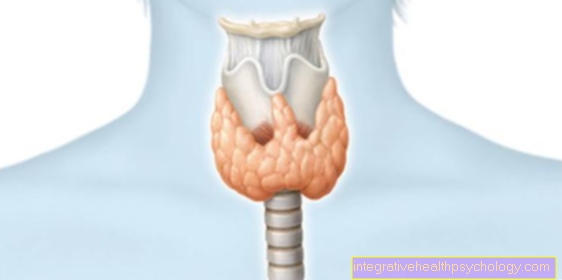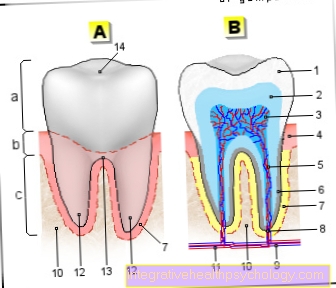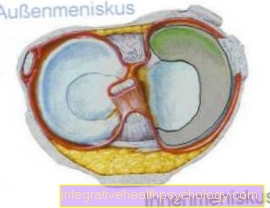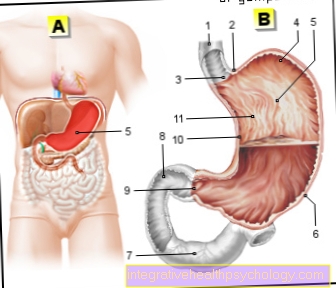Heart muscle inflammation on the EKG
introduction
The EKG is a procedure that can be used to record electrical signals from the heart. It is a very simple and inexpensive examination method, so that it is available almost everywhere. The ECG can basically give initial indications of a heart disease, but it is not particularly applicable to the diagnosis of myocarditis. This is mainly due to the fact that myocarditis itself can take on very different clinical manifestations. The EKG is therefore very valuable as the first diagnostic tool, but depending on the findings, additional procedures such as imaging (X-ray, ultrasound or MRT) must be used.

What ECG changes does myocarditis make?
The ECG changes caused by myocarditis are very diverse and present just as differently as the clinical symptoms of the disease. Since the EKG records the electrical currents in the heart, cardiac arrhythmias in particular can be shown. These disorders range from having an overly fast heartbeat (Tachycardia) about the additional heartbeats (Extrasystoles) to a severe arrhythmia in which the heart can no longer produce efficient beats.
Because the heart's electrical currents are diverted at different points, disturbances in the conduction of excitation can be easily localized, and it is also possible to estimate the size of the affected area and thus the severity of the disease. In myocarditis, a phenomenon similar to that of a heart attack can occur. It is known as ST segment elevation. The distance between the S wave and the T wave is raised in the recorded EKG and is no longer on the zero line. An ST segment depression or a T-wave negation, in which the normally positive T-wave points in the opposite direction, are just as possible. In addition, severe conduction disorders that affect an entire heart chamber can be diagnosed. Such a disorder is known as bundle branch block.
Further information on the topic can also be found at: EKG- That means the waves and spikes
Extrasystoles
A heartbeat consists of the tension phase (Systole) and the relaxation phase (diastole). In the diastole, the heart chambers fill with blood, which is pumped into the circulation in the systole by tensing the heart muscles. Extrasystoles are additional beats of the heart. They are sometimes referred to as palpitations. They usually occur as a result of impaired conduction of excitation. This disorder can be triggered, for example, by an inflammation of the heart muscle. A ventricular extrasystole, in which the conduction disturbance is in the ventricles, is differentiated from a supraventricular extrasystole, in which the conduction disturbance is in the atria.
Please also read:
- Extrasystole
- How to recognize palpitations!
- Heart palpitations - how dangerous is it?
Tachycardia
Tachycardia is the technical term for a heartbeat that is too fast. This can be the result of an inflammation of the heart muscle, for example. The inflammation disrupts the heart's conduction system. The electrical impulses that generate a normal heartbeat are incorrectly transmitted and send signals to the heart muscle cells that are too fast in the atria or ventricles. These contract and pass the too fast signal on to the next cells. This can throw the entire heart rhythm out of balance.
Further information can be found at:
- Racing heart (tachycardia)
- Palpitations at night - is that dangerous?
Conduction disorders: AV block and bundle branch block
The so-called AV node is located between the atria and the ventricles. This conducts the electrical excitation from the atria into the heart chambers, where it causes the muscle cells to contract. This conduction can be disturbed by an inflammation of the heart muscle. In this case, the AV node blocks the transmission of electrical currents and the heart twitches very irregularly. This is called an AV block. Usually the atria and ventricles beat together independently and no longer evenly.
If this electrical conduction disturbance occurs a little further below, a bundle branch block can occur here. The left branch of the heart is often affected, so it is referred to as a left bundle branch block. A left bundle branch block means that no electrical signals are sent to the left ventricle. As a result, they do not move and no blood is pumped into the circulation. This part of the heart stands still.
Please also read: AV block
Myocarditis without a change in the ECG?
The EKG is able to measure electrical signals in the heart. This enables all disturbances in the cardiac conduction system to be recorded. Heart muscle inflammation often triggers such changes. However, there are definitely cases in which there is no interference with the electrical signals. The ECG is usually not or only very slightly changed. For example, defects in individual heart muscle cells cannot be shown in the EKG. Even if the excitation conduction is disturbed in these individual cells, this is not noticeable in the ECG. Changes in the ECG can only be determined when the defect is of a certain size.
Even if the heart muscle cells are weakened by the inflammation, but they still transmit the electrical signals, the EKG is usually normal. The affected person may already have major cardiac function impairments without this being recognizable in the ECG.
In addition, myocarditis can be accompanied by water retention in the pericardium. This accumulated fluid takes up space from the heart, so that its pumping function is restricted. However, the deposits cannot be measured using an EKG. Therefore, an imaging procedure (X-ray, ultrasound or MRT) should always be performed in addition to the ECG.
For more information, see: Water in the pericardium
Alternative diagnoses
The changes that occur in the ECG in inflammation of the heart muscle can have various other causes. If there is no heart muscle inflammation, the origin of the phenomenon is usually another heart disease.
When doing the ST segment elevation, a heart attack must first be considered. Cardiac arrhythmias can also be triggered by a heart attack. Heart muscle cells perish in the infarct due to a reduced blood supply. This can disrupt the electrical signal line.
Furthermore, phenomena such as AV block, left bundle branch block, tachycardia or extrasystoles can occur as individual heart diseases. The triggers for these diseases are varied. Other myocardial diseases, such as cardiomyopathy, can also show a picture similar to that of myocarditis in the ECG. The weak heart (Heart failure) is associated with a general functional restriction and thus with a weak pumping of the heart and can possibly be confused with an inflammation of the myocardium in the EKG.
This article might also interest you: Symptoms of heart failure







.jpg)




















.jpg)
.jpg)